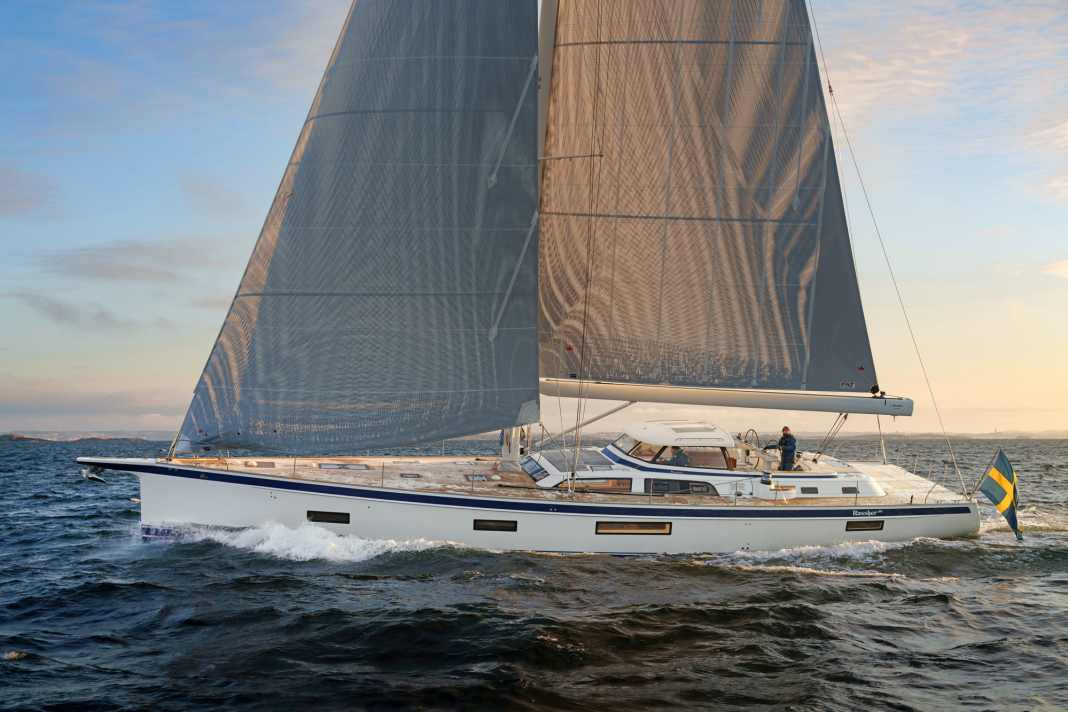





- Push-button sailing in perfection
- The Hallberg-Rassy 69 demonstrates pragmatic long-distance cruising capability
- The Hallberg-Rassy 69 shows strong sailing performance with ease
- Measured values Hallberg-Rassy 69
- YACHT review Hallberg-Rassy 69
- Technical data Hallberg-Rassy 69
- Equipment and prices Hallberg-Rassy 69
In the almost 21 years that he has been in charge of the shipyard, he has already experienced a lot. But the excitement surrounding his latest model, the largest ever built to date and probably for a long time to come, never ceases to amaze Magnus Rassy.
On the one hand, there are those who have been working their fingers to the bone about the HR 69 on the brand's popular social media pages. Some criticise the lack of grab handles in the saloon without ever having been on board. Others criticise the draught of 2.70 metres and the yacht's huge dimensions, which supposedly make many harbours and anchorages inaccessible. Still others passionately debate whether such large and expensive boats are not generally reprehensible.
The total construction time is almost one and a half years - five months for the hull and deck, eleven for the interior"
The Hallberg-Rassy 69 leaves no one cold
On the other hand, the brand's new flagship has been met with almost unanimous enthusiasm. The number of hits on the previous reports on YACHT online broke all records. And when the construction number one went into the water for the first time at the end of November, Magnus Rassy registered a phenomenon that he had never seen before: Almost every week, a paparazzo photo of the trial runs appeared in the regional media. One particularly dedicated ship lover even asked him to turn up outside his living room window at the next opportunity and to call in advance so that he could get the best possible shot of the 69.
No, these 22.22 metres of Scandinavian boat building can't leave you indifferent - especially not live and in 3D. At the pier of the Ellös shipyard harbour, the yacht looks even more impressive than cameras could ever capture. Although everything appears to be the same as always - the positive deck plan, the bulwark, the blue trim strips and the rubbing strake laminated into the hull form - the Hallberg-Rassy 69 looks completely different: more elongated, more present, simpler and yet downright majestic.
Proven solutions, also in XXL format
Not even the white fan cowls behind the hatches seriously detract from the otherwise completely flat foredeck, which stretches from the mast almost to the horizon. The hoods are an indication of the Swedes' strength of character, which will be discussed later, because they characterise the boat as a whole. They ensure permanent, highly efficient and absolutely watertight ventilation throughout the entire boat, even in the event of a seaway. However, you won't find this anywhere else in the luxury class.
Elsewhere, chrome-plated dorado fans are installed in their place, which can be removed along with the associated protective brackets. Or the deck openings are omitted altogether and the fresh air supply is ensured by fans running inaudibly in the engine room or at the very stern, which is also no problem with the large battery packs including solar chargers and diesel generators in this league of extraterrestrials. Magnus Rassy, however, swears by tried and tested solutions, even in XXL format. He even accepts the fact that half a dozen plastic hoods are spread across the imposing sheer size of the foredeck.
Push-button sailing in perfection
Of course, you shouldn't conclude that everything is the same here. The special features that set the Hallberg-Rassy 69 apart from its smaller sisters and from the relatively straightforward competition are just less obvious. These include practical solutions such as the flushing device integrated into the chain guide of the bowsprit, which keeps the anchor locker clean. The shore power cables rolled up on electrically driven drums below deck are also a clever solution, especially as there are two of them: one for the 60 hertz network common in parts of the Caribbean and the USA, and one for the 50 hertz supply used throughout Europe.
Ease of use was a top priority in the specifications anyway. Winches, furlers, boom vang and backstay of the Swedish flagship are hydraulically operated due to the enormous forces involved. On request, this also applies to the halyard tension, which perfects the principle of push-button sailing. Coupled with load sensors whose data is shown on a display at the helm, the trim can be reproduced virtually according to a table.
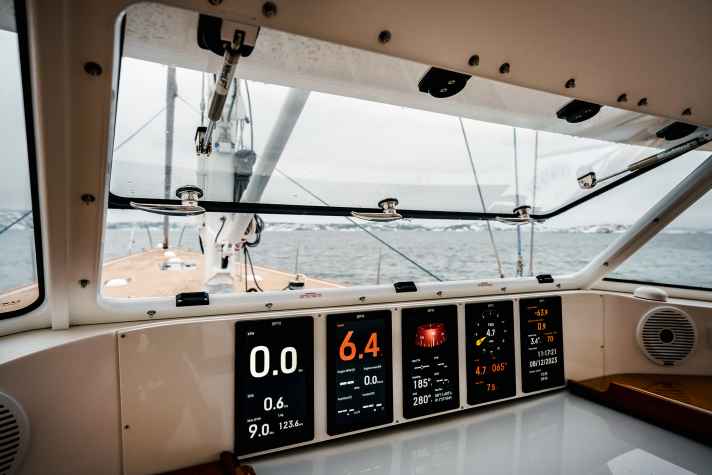
Preset threshold values prevent accidental damage if the finger remains too long on the button that is tightening the main halyard, for example. Otherwise, the hydraulic cylinders mounted on the port side of the mast would undoubtedly be able to cause the pulleys and halyard to burst.
Manoeuvres with centimetre precision in the tightest of spaces
Magnus Rassy has equipped the boat, which he intends to use himself for a summer or two as usual in order to be able to optimise any details, with pretty much every technical refinement. In addition to the carbon fibre mast and the performance sail set with hydraulically furled Code Zero, this also includes a stern thruster and a wireless remote control for harbour manoeuvres. It allows you to move freely on deck and manoeuvre with centimetre precision.
In addition to bow and stern thrusters, both manufactured by Sleipner, the Dockmate system also controls the Volvo Penta diesel engine. It acts like a reduction gear: this allows the luxury cruiser, which displaces around 50 tonnes with full tanks, to be laid gently alongside the jetty or a mooring at creep speed.
However, the HR 69 can also perform a fast-paced harbour ballet if required. If you turn the thruster levers in opposite directions, you can rotate on the spot with such speed that the foredeck crew gets dizzy. If you push off from the pier at full power, the swell is as if the surf were breaking into the harbour basin.
The Hallberg-Rassy 69 demonstrates pragmatic long-distance cruising capability
Undersized is a word that never comes to mind anywhere on the boat. The six-cylinder engine produces 300 hp; 180 hp four-cylinder engines are common on yachts of this calibre. The Cummins generator produces 17.5 kilowatts; the competition leaves it at 11 kW units. The anchor weighs 80 kilograms; according to the recommendations of Germanischer Lloyd, only 50 kilograms would be necessary. A 75-litre boiler would have been sufficient for the hot water supply; the Rassy has two on board.
The list goes on and on. And it is not mere gigantomania that has dictated the equipment, but once again pragmatism that has been very consciously trimmed for long-distance cruising.
In combination with the matching four-blade overdrive propeller from Gori, the powerful diesel engine allows extremely low-speed and low-noise cruising. At just 1,500 rpm, the HR 69 is already travelling at 8.8 knots on smooth water - only 0.7 knots slower than at 2,000 rpm. This reduces the perceived sound pressure in the aft owner's cabin by half (66 instead of 72 decibels). The range under engine also benefits enormously: the boat can cover a good 1,600 nautical miles without refuelling; at 2,000 rpm it is still a good 1,100 miles.
The Hallberg-Rassy 69 shows strong sailing performance with ease
Anyone who thinks that the engine might have to make up for sailing deficits is way off the mark. Rather, the Rassy is one of the most capable and enjoyable yachts for long sea voyages. During the two-day test in mid-December, the Volvo Penta never once reaches operating temperature - and this is only partly due to the fact that the seawater flowing through it is just four degrees above zero out in the Skagerrak. Apart from mooring and unmooring, the engine is simply not needed, even though the wind inside the archipelago is only blowing lightly from the north-east at six to eight knots.
As soon as the main is upright, the log jumps to a speed of 4.5 to five knots through the water. As soon as the Code Zero is furled, the boat is travelling at seven knots, and as the breeze picks up, the HR 69 soon logs double-digit figures consistently out on the open sea, without the need for any special effort.
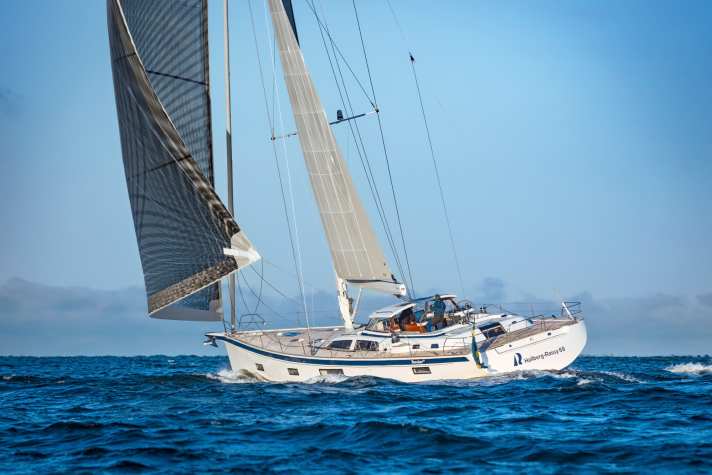
High speeds are to be expected from a ship whose hull speed is 10.8 knots due to its length. But here, with only minimal wave support, the ease with which the yacht exceeds this limit is impressive. With a strong oscillating wind of 14 to 16 knots, the Rassy runs at a top speed of 13.3 knots on the beam and between eleven and twelve knots over long stretches - averaged and adjusted for current, mind you. This makes daily distances of 250 nautical miles and more a matter of course.
The Hallberg-Rassy 69 is a joy on the cross
As usual with the boats from Ellös, the Rassy has clear feedback from the rudder, which is not a matter of course in the large luxury cruiser segment. However, it requires a firm hand and concentration. This is because the highly effective steering of the twin rudders shows some play in the construction number one. As it responds very directly around the neutral position, it takes some getting used to in order to keep the boat precisely on course, especially in the strong winds near the coast.
On the cross, the HR 69 finds its track more easily and also shows a better balance. It is a pleasure to go upwind with her. Turning angles of less than 90 degrees are no problem, and the speed is simply inspiring: the yacht marches against the waves at nine to 9.5 knots, only taking on seawater on the foredeck and, thanks to the high righting moment, remains pleasantly stiff at only around 20 degrees - ideal for a cruising boat.
The heating is worth every cent
It still conveys this fascination as it makes its way back through the slightly snow-covered rocky islands in the afternoon twilight. The speed and pressure drop noticeably, but the fun remains. Indeed, it is almost intensified because the Rassy remains lively even at six to 6.5 knots on the wind, runs well upwind and gives the crew a feeling of immediacy and directness, as if she were a 40-footer. It is a sensation all of its own that emanates from it: perhaps its greatest strength, because it is its quietest.
What could not be tested in the minus six degree air temperature in December was the ventilation through hatches and cabin windows. However, it appears to be above average because even the front superstructure windows can be opened. There are also the numerous mushroom ventilators in the deck, which ensure a constant exchange of air. In any case, the capacity and control of the Kubota water-operated diesel heater were easy to assess under the given conditions. At almost 55,000 euros, it costs a lot, but is worth every single cent. It can regulate the temperature in each cab electronically to the exact degree; at minus ten degrees outside at night, it can conjure up a cosy 24 degrees or more inside if required.
Close relationship in the Hallberg-Rassy family
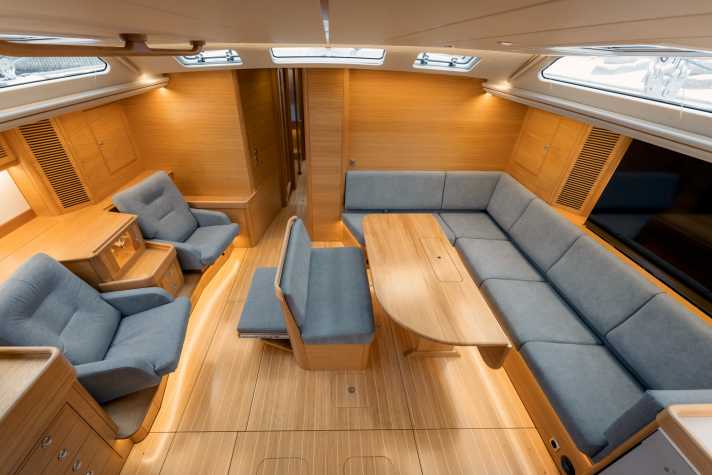
In terms of atmosphere, all Hallberg-Rassy yachts are warm and cosy from the ground up. The 69 is no exception with her all-wood coachroofs, the traditional and modern interior and the solidity that can be felt everywhere. In terms of glazing, however, she sets new standards for the brand, as the hull windows in particular are now significantly larger and also more beautifully integrated. In the saloon, they measure almost two metres in length, which makes elaborate bracing necessary. You have to love them for that alone.
This makes it all the more surprising that it otherwise has the same rotary latches for drawers and lockers as the HR 340, which is not even half the size, the same wood, the same fittings in the heads and galley. She is a typical Rassy, only larger, more self-sufficient and technically more sophisticated.
The Hallberg-Rassy 69 has remained an owner's yacht
And she has remained an owner's yacht, as was already evident when sailing. This is made clear by the layout of the cockpit and, even more so, the cabin. Neither is primarily designed for travelling with a skipper and deckhand.
It is possible, without a doubt, but it is more likely to be the second-best solution. After all, if you want to accommodate a professional crew appropriately, you have to provide the entire forward cabin for this purpose - and then only have two small guest cabins amidships for friends or family. Alternatively, the crew can be accommodated in the passageway to the owner's cabin, which, of course, requires a spatial proximity that both sides tend to avoid today.
In this respect, Magnus Rassy is not only the first, but also the best possible owner for this boat. He wants to run his "Rassker 69" without outside help. He is right!
Video tour of the Hallberg-Rassy 69
Measured values Hallberg-Rassy 69
Sailing performance
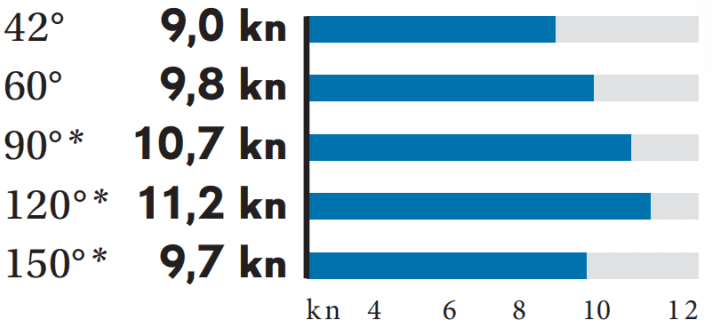
(without drift/current); wind speed: 12 to 16 kn (4 Bft), wave height: approx. 1 m
* with Code Zero
Potential STZ* = 4.1

Even with optimised Epex membranes (STZ: 4.4), the sail area is typical for a cruising yacht
* Dimensionless number. Calculation: 2√S/3√V. The higher the value, the more sail area (S) the ship has in relation to the displacement (V)
Sound pressure
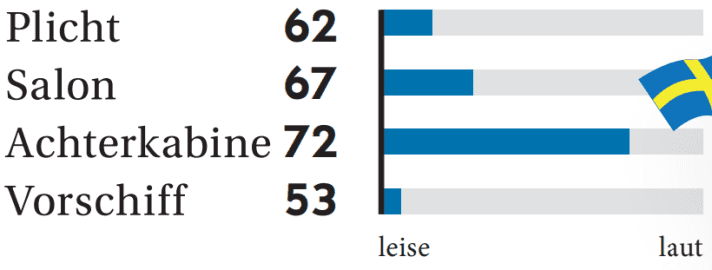
In dB(A), measured at cruising speed (70 % of maximum speed): 9.5 kn, 2,000 min-1
Cockpit dimensions

YACHT review Hallberg-Rassy 69
The Hallberg-Rassy 69 sets standards not only because of its sheer size. She is also probably the most autonomous yacht in this league of aliens. The fact that she is still close to her little sisters makes her likeable
Design and concept
- + Solid, durable design
- + Timelessly elegant hull lines
- + High stability range
Sailing performance and trim
- + Very good crossing properties
- + High base speed
- + Very easy sail handling
- +/- Good feedback from the rudder, but too much windward yaw
Living and finishing quality
- + Bright, cosy extension
- + Good ventilation, plenty of storage space
- - Berth in starboard cabin too narrow
- - Layout not optimal for use with skipper/crew
Equipment and technology
- + Very good standard equipment
- + Well-organised dinghy storage space
- - Very high price
Technical data Hallberg-Rassy 69
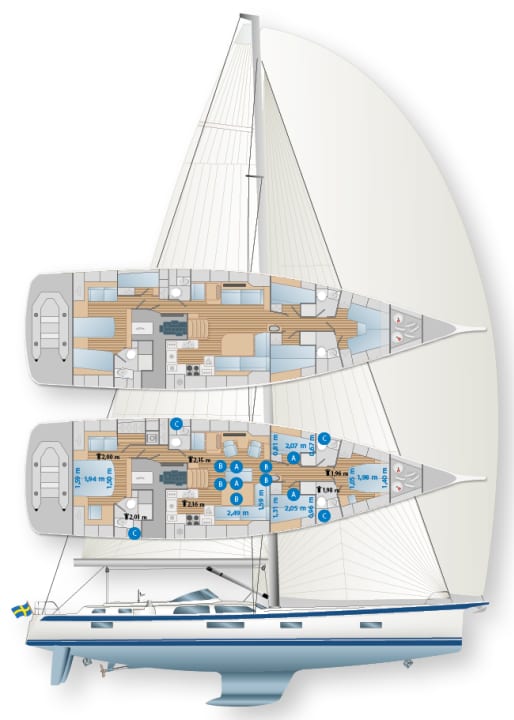
- Design engineer: Germán Frers
- CE design category: A
- Torso length: 20,96 m
- Total length: 22,22 m
- Waterline length: 19,70 m
- Width: 5,89 m
- Depth: 2,70 m
- Mast height above waterline: 31,30 m
- Theoretical torso speed: 10.8 kn
- Weight: 46,5 t
- Ballast/proportion: 17,3 t/37 %
- Mainsail: 108 m²
- Furling genoa (105 %): 108 m²
- Machine (Volvo): 221 kW/300 hp
- Fuel tanks (5): 2.200 l
- Fresh water tanks (4): 1.700 l
- Faeces tanks (4): 370 l
- Batteries: 24 V/460 Ah
- Cooling volume: Fridge/box 131 l, freezer box 53 l
Hull and deck construction
GRP foam sandwich, laminated using the vacuum infusion process. Isophthalic gelcoat, vinyl ester barrier layer
Sail
The HR 69 comes with Epex laminate straight from the shipyard, but without battens. The performance sail set has 15 per cent more surface area (247 instead of 216 square metres)
Rig
The standard boat has a three-salings rig from Seldén made of aluminium. The optional carbon fibre mast is the same height, but 300 kilos lighter
Drive
With the 300 hp six-cylinder engine, the yacht is generously motorised - good for low revs and low consumption. Recommended extras: Gori propeller with overdrive (surcharge €15,260) and retractable stern thruster (€62,860)
Navigation electronics
Hallberg-Rassy has relied on Raymarine for years. The freely configurable Alpha displays above the companionway (€11,850) were a favourite feature of the test ship
Rudder
Like all current Rassys, the flagship also has two rudder blades and space for a dinghy garage
Stability
Thanks to its 37 per cent ballast content and wide frame shape, the 69 has a very high righting moment
Entertainment
A retractable 50-inch television is available in the saloon on request. Surcharge incl. aerial €8,180. Air conditioning costs €54,430
Shipyard and distribution
- Shipyard: Hallberg-Rassy, 47431 Ellös, Sweden. www.hallberg-rassy.com
- Distribution: Hallberg-Rassy Deutschland GmbH, An der Wiek 7-15, 23730 Neustadt, phone 04561/55 86 48, info@hallberg-rassy.de
Equipment and prices Hallberg-Rassy 69
Base price ex shipyard: 6.030.400 €
Standard equipment included: Engine, sheets, railing, navigation lights, battery, compass, sails, cushions, galley/cooker, bilge pump, toilet, fire extinguisher, electric cooler, holding tank with suction, antifouling, clear-sailing delivery with full diesel and fresh water tanks
Price ready to sail*: 6.030.400 €
Guarantee/against osmosis: 2/2 years
* How the prices shown are defined can be found here!
Surcharge for comfort equipment
- Line-adjustable hole points: inclusive
- Traveller with line guide: inclusive
- Electric windlass: inclusive
- Hydraulic tube kicker: inclusive
- Hydraulic backstay tensioner: inclusive
- Jumping cleats: inclusive
- Sprayhood: inclusive
- Teak in the cockpit: inclusive
- VHF radio: 3.580 €
- Log and echo sounder: inclusive
- Wind measuring system: inclusive
- Autopilot: 16.530 €
- Charger: inclusive
- Shore connection with RCD: inclusive
- 230 volt socket: inclusive
- 12-volt socket in the sat nav: inclusive
- Heating: 54.430 €
- Pressurised water system: inclusive
- Hot water boiler (2x 75 litres): inclusive
- Shower WC room: inclusive
- Cockpit shower: 890 €
Comfort price*: 6.105.830 €
* How the prices shown are defined can be found here!
Included in the price:
PU deck in teak look, cockpit table, retractable bow thruster, hydraulic bathing platform, hydraulic winches and furling systems, electric toilets, 17.5 kW generator, combined 100 Ah charger with 3.5 kW inverter

